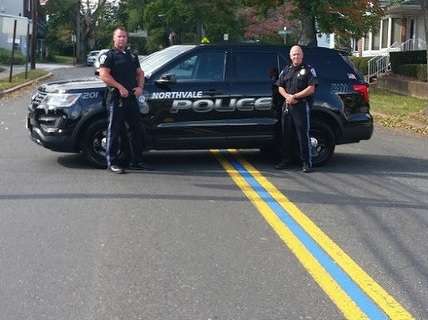Feds Nix NJ Municipalities' Practice of Painting Blue Lines in Road to Show of Support to Police
A county engineer asked the FHA for guidance about the practice, and found out it violated federal regulations.

A number of towns in New Jersey decided to paint blue lines in the middle of their roads as a show of support for local law enforcement ("the thin blue line"), but after the chief engineer of Somerset County sought clarification from the federal government about the practice before committing to a blue line there, they've found that the practice violates federal regulations on road markings. Some towns are already having the lines removed.
Road markings in the U.S. are governed by the federal Manual on Uniform Traffic Control Devices for Streets and Highways (MUTCD), because apparently without federal standards the roads would fall into a state of anarchy.
Mark R. Kehrli, the director of the Office of Transportation Operations at the Federal Highway Administration, wrote to the Somerset County chief engineer to tell him that the blue lines violated federal regulations.
"Section 3A.06 of the MUTCD states that the pattern of a longitudinal double line shall be two parallel lines separated by a discernible space," Kehrli wrote. "For this space between the two lines to be discernible it must represent a lack of other markings. Accordingly, the pavement surface must be visible in the space between the lines in the same way that it is visible outside the lines. On this basis alone, filling in the gap in a double line, either partially or fully, does not comply with the provisions of the MUTCD."
The use of the color blue was also problematic. Kehrli cited a 2013 official ruling on "Application of Colored Pavement," which stated:
Blue is not a colored pavement and is not to be used as such in accordance with Paragraph 3 of Section 3G.01. Blue as it applies to a pavement marking is exclusively reserved for the background color in the international symbol of accessibility parking symbol (see Figure 3B-22) and for the supplemental pavement marking lines that define legal parking spaces reserved for use only by persons with disabilities as provided in Paragraph 5 of Section 3A.05.
"There are many appropriate and fitting ways to recognize service to the public that do not involve the modification of a traffic control device, which can put the road user at risk due to misinterpretation of its meaning," Kehrli wrote. The idea that a blue line in the middle of a road might be misinterpreted by anyone as signaling a disabled parking spot is preposterous, and a great illustration of the inanity of so many federal regulations.
An effort's already underway to get a state law that would permit municipalities to paint blue lines in the middle of the road, with Somerset County Sheriff Frank Provenzano lobbying state lawmakers about it. The president of the state PBA, meanwhile, criticized the FHA's priorities. "I hope the FHA has more important things on their to-do list," Patrick Colligan told NJ.com. Nevertheless, he said he supported Provenzano's efforts although he questioned the need to "legislate a blue line."
Colligan's questioning of the FHA's priorities work just as well, however, for the entire exercise. Don't municipalities, also, have more important things on their to-do lists than spending money to paint blue lines in the road? "Although absurd, we would paint over the approximately 200-foot line if required," the Howell police chief Andrew Kudrick told NJ.com. "I'll just paint the entire parking lot blue at the police department."
Semi-related: Last year, a state mandate requiring local jurisdictions to purchase body cameras was ruled unconstitutional because the state didn't cover the costs of the cameras. Although body cameras may be more expensive than painting blue lines (though that's far from certain given the inflated costs of government labor), avoiding symbolic expenditures leaves more of the money municipalities extract from their residents on the kinds of things, like body cameras, from which they might actually benefit.


Show Comments (106)